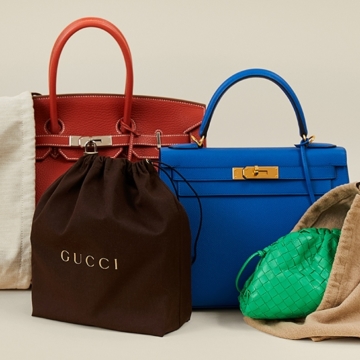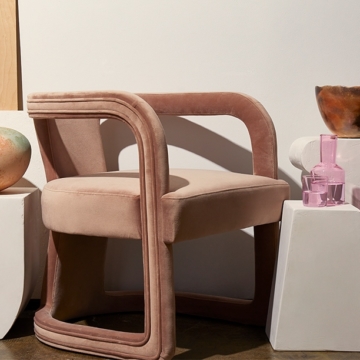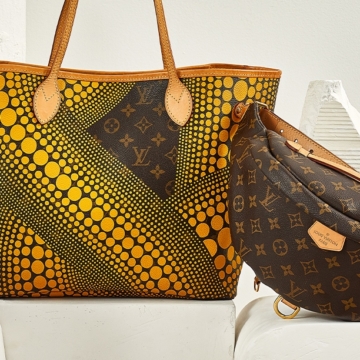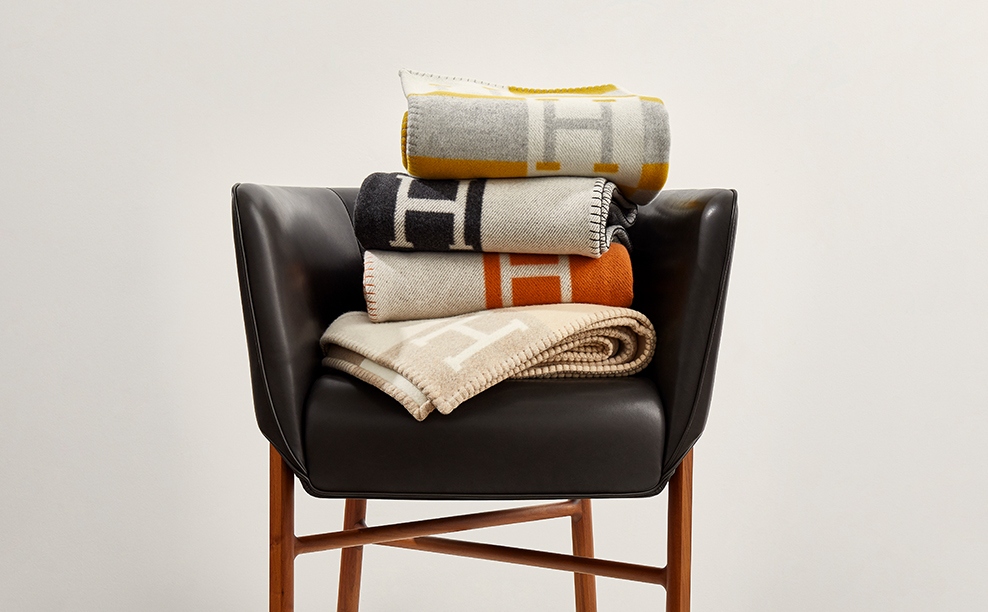
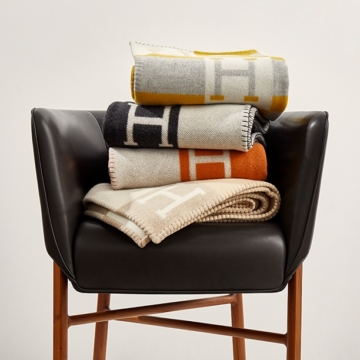
TRR Top 5: Home & Furniture Designers With The Best Resale Value
Saying that furniture is an important aspect of your home is an understatement. Not only does furniture influence the aesthetics of your space, but it also influences your quality of life. Whether you spend countless hours searching the Internet for particular furniture designers or spend your weekends trolling antique stores for rare gems, there’s nothing like finding that perfect piece.
Of course, everyone feels like changing things up now and then, and if you’re feeling stuck, you need not worry about parting with the pieces you paid top dollar for. Well-made furniture and decor are, in fact, smart investments. Furniture designers who have prioritized craftsmanship, impeccable materials and design produce pieces that, if you maintain them properly, will serve you for years to come — plus earn you money in the resale market if you choose to re-sell.
Home & Art Valuation Manager Hannah Hammett did the heavy lifting and unearthed key information about the furniture designers with the best resale value. Read on for her expert insights into the history of sought-after pieces, tips for spotting the real deal and care guidelines for keeping your furniture and home items in top resale condition. Then sell yours when you’re ready (and don’t forget to book a virtual home and art consultation if you’d like face time with one of our specialists).
Hans Wegner
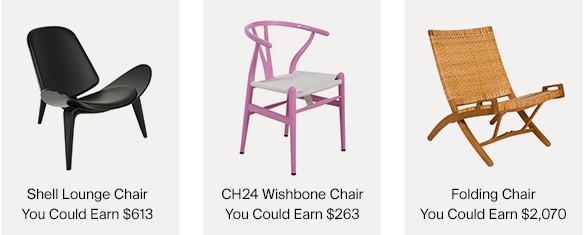
Hans Wegner Shell Lounge Chair; Hans Wegner CH24 Wishbone Chair; Hans Wegner JH512 Folding Chair
The Designer Details: Hans Wegner is among the most prolific furniture designers to come out of the Danish Modern movement in the mid-20th century. A master woodworker and former cabinetmaker, he designed over 500 chairs in his lifetime. His unique approach to furniture design combined Minimalism — the idea of reducing each piece to its most simple form and function — with a deep appreciation for wood and a curiosity for other organic materials.
Resale Stats: Hans Wegner’s CH24 Wishbone Chair has an average resale value of 85%. Wegner’s JH512 Folding Chair was only produced by Johannes Hansen until 1969, and original JH models are highly sought-after with significant resale value fluctuating from $3,500 to upwards of $10,000 per chair.
The Stories Behind The Styles: The Shell Lounge Chair was designed in 1963 and produced in limited quantities due to under-developed and costly manufacturing techniques, but it didn’t receive the proper accolades until decades later. Early production CH07 chairs are incredibly rare, residing as permanent fixtures mostly in museums or private collections. When it was re-released in 1998, it captivated a new generation.
The 1949-era CH24 Wishbone Chair was created for Carl Hansen & Søn, and is perhaps Wegner’s most recognizable design. The chair is inspired by a style of Chinese lounge seat created during the Ming dynasty. The soft curve of the backrest is achieved by applying hot steam to the wood and manipulating it by hand.
Also created in 1949, but for design studio Johannes Hansen, is the JH512 Folding Chair — another manifestation of Wegner’s love for uncomplicated design and natural materials. The solid oak JH512 was designed with a small living space in mind. The chair is hinged at the base to fold flat and features a notch at the cross bar for hanging the unit on the wall when not in use. The hand-woven rattan seat and backrest are concave, comfortably cradling the user. The chair is still produced today, though by PP Møbler.
Hans Wegner CH24 Wishbone Chair Authenticity Tips: Construction of each CH24 Wishbone Chair is meticulous, requiring more than a hundred steps to manufacture each chair to completion. The backrest should be one solid piece of bent wood, and any seams or joining here is an indication of a reproduction. Also, though labeling conventions have changed through the years, all CH24 chairs should be labeled by Carl Hansen & Søn. Later models are produced with a unique serial number and bear Hans Wegner’s signature on the label plaque.
Herman Miller
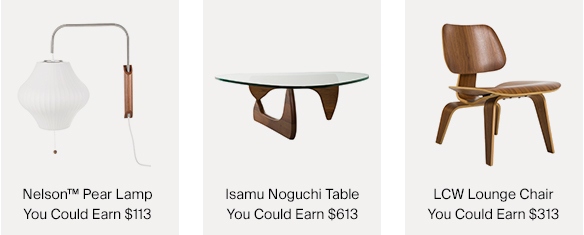
Herman Miller Nelson Pear Lamp; Herman Miller Isamu Noguchi Table; Herman Miller Eames LCW Lounge Chair
The Designer Details: Herman Miller began as the Star Furniture Company in 1905 in Zeeland, Michigan. It wasn’t until 1923 that the company was named after majority stakeholder Herman Miller. The company produced traditional wood furniture until the Great Depression, when the dwindling market demanded modern designs. George Nelson became director of design at Herman Miller in 1945, and for forty years his creative vision helped shape the company into the legend of mid-century modern design that it is today.
Resale Stats: Nelson Bubble lamps have an average resale value of up to 75%, and the majority of listings sell in fewer than 10 days. Isamu Noguchi coffee tables hold an average resale value up to 65%, and the iconic Eames LCW Lounge Chair carries an average resale value of up to 50-60%, with the Walnut and Santos Palisander finishes being slightly more desirable than the color finishes.
The Stories Behind The Styles: In 1953, George Nelson produced his iconic Bubble lighting series. Available in an affordable variety of organic shapes (including the Pear), the Bubble series comprised floor, table, ceiling and sconce models. Nelson was inspired by ethereal silk lighting that he came across in Sweden, but was repulsed by the expense of the materials. He instead used a translucent white plastic spray created by the U.S. military over the wire frames of his pendants.
Japanese-American artist Isamu Noguchi created the Noguchi table for Herman Miller in 1948. Consisting of a simple interlocking wood base, and a uniquely shaped glass top, the Noguchi table is a modern sculptural approach to a traditional living room staple. Noguchi produced a significant number of large-scale public installations over his lifetime including sculptures, fountains, playgrounds and gardens that can be found in civic spaces and at cultural sites worldwide.
Charles and Ray Eames are the most influential couple in mid-century modern design in America. During WWII, the duo created molded plywood splints for the military fighting overseas. Most materials manufactured in the US at that time were created and dedicated to the allied efforts, and after WWII the surplus of these industrial materials were then utilized by designers to create furnishings for the baby boom that followed. The Eames LCW (Low Chair Wood) first manufactured by Evans Products Company in 1946 is a prime example, utilizing the same techniques and materials as the Eameses’ molded plywood splint. Herman Miller gained the rights to produce the LCW in 1947, and has been the sole US manufacturer since 1949.
Eames LCW Chair Authenticity & Care Tips: The earliest examples of the Eames LCW chair were manufactured by Evans Products Company from 1946-1949, and Vitra has produced the chair in Europe since. All other authentic examples of the Eames LCW will be labeled by Herman Miller. The backrest is affixed with two screws and features two rubber shocks which should measure 1.5 inches in diameter for most models, and 3 inches for the rare early models. If you think you have an early model LCW, the shocks will be a dead giveaway — they should be brittle due to age.
Like a sensitive houseplant, an LCW chair should be kept out of direct sunlight. Sunlight can cause the wood to fade or bleach.
Hermès

Hermès Porcelain Ashtray; Hermès Avalon Blanket; Hermès Cabriolet Chair
The Designer Details: Hermès began as a sellier, or saddle and harness-making workshop, in 1837, and is now best known for fabricating everything from luxurious leather handbags and hand-rolled scarves to ready-to-wear and beauty products. The atelier’s fine furnishings and home decor are highly coveted, and maintain the same level of expert craftsmanship that is present in their clothing and leather goods.
Resale Stats: Porcelain Hermès ashtrays maintain an average resale value up to 75%. The highly recognizable Avalon blanket keeps an average resale value of up to 90-95%, while the Les Nécessaires d’Hermès Cabriolet Chair sells for up to 70% of its retail price in the secondary market.
The Stories Behind The Styles: Hermès ashtrays are made of fine porcelain from Limoges, France, and have been produced in dozens of eye-catching designs. This pattern is finished with 24K gilt, at both the grooves and trim.
The Avalon Blanket, first released in 1988, is arguably as iconic as the Birkin (and is often considered the “Birkin of the Home”). It is in as many designer and celebrity residences as the bag is in fashionable closets. It was an Hermès Avalon that famously consoled Carrie Bradshaw in Charlotte’s chic Park Avenue apartment in the Sex and The City film. The Avalon is currently made of 90% Merino wool and 10% cashmere, and features an H-clad jacquard pattern. Variations of the Avalon have been produced with a ratio of 85% wool to 15% cashmere, as well as in 100% cashmere. Many limited-run patterns and colors of the Avalon have been released by Hermès over the years.
The Les Nécessaires d’Hermès Cabriolet Chair by French designer Philippe Nigro first launched in 2013 as part of an eight-piece capsule collection for Hermès, which also includes an ottoman and coat rack. The series centers on essentials over excess, combining pared-down design with multifunctionality. Traditional cabriolet chairs were popularized in France during the royal reign of Louis XV, and are distinguished by the gentle curve of the backrest. Philippe Nigro’s modern interpretation is constructed of Canaletto Walnut, a North American hardwood, and is finished with Taurillon H leather upholstery.
Hermès Avalon Blanket Authenticity & Care Tips: Each standard Avalon blanket should measure 53 x 67 inches, and is finished with a Cocotte stitch trim. The brand and fabric labels should be sewn onto one corner of the blanket’s underside, and the wool-blend Avalon blankets should list either Great Britain or Scotland as their country of origin.
Wool is naturally antibacterial and repels water. Hot water in your washer or hot air in your dryer will cause the fibers to shrink and fracture, so to keep your Avalon blanket fresh, dry cleaning is recommended. In between professional cleanings, try giving your Avalon blanket a good shake and hang it in a space that has natural airflow. If you need to spot-clean, use only cold water, preferably a bubbly seltzer, which can isolate and lift away debris.
Fritz Hansen
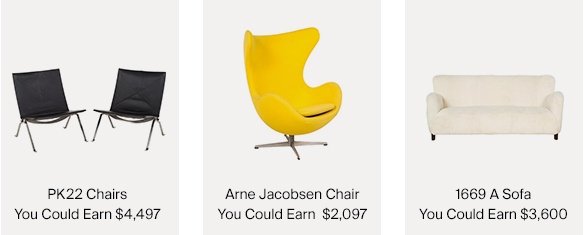
Fritz Hansen PK22 Chairs; Fritz Hansen Arne Jacobsen Egg Chair; Fritz Hansen 1669 A Sofa
The Designer Details: Fritz Hansen was a Danish carpenter, and one of the first designers to embrace the steam-bending wood process to produce domestic furniture. His first bentwood chair design was released in 1915, and it was his collaboration with innovative designers like Arne Jacobsen and Poul Kjaerholm that gained his company worldwide recognition.
Resale Stats: Models of PK22 chairs with leather upholstery are highly desirable in the secondary market, holding an average resale value of up to 70%. The Model 1669 A sofa and chair designs have not been re-issued since their initial limited release in the 1940s, making authentic examples very difficult to find. The secondary market value of the Model 1669 A sofa currently ranges from $5,000-$7,000.
The Stories Behind The Styles: The PK22 Easy Chair was designed by Poul Kjaerholm — who apprenticed with Fritz Hansen — in 1956. Kjaerholm was trained as a carpenter, yet interestingly embraced steel as a manufacturing material when he moved into furniture design. The PK22 was initially produced under manufacturer Ejvind Kold Christensen, but after Kjaerholm’s death in 1980, Fritz Hansen assumed production of the PK series.
The Egg Chair was designed by Arne Jacobsen in 1958 for the SAS Royal Hotel in Copenhagen. Created in the early years of the Space Race, the chair echoes the atomic influence of the era. The precise shape was perfected over many experiments with clay in Jacobsen’s garage.
The Model 1669 A Sofa was designed by Fritz Hansen himself in 1938, as part of a living room suite that included an identical easy chair. The modern seat is upholstered in lush faux sheepskin and the angled feet feature rounded edges that complement the sofa’s curves.
Fritz Hansen 1669 A Sofa Authenticity & Care Tips: Authentic Model 1669 A sofas should include the model number, printed directly on the wood frame at the underside of the base. This is only accessible beneath the upholstery. The uniquely angled solid wood feet on the sofa are also a good indication of an authentic piece; if these feet are attached to the base with glue or have visible fasteners such as screws or nails, the piece was not manufactured by Fritz Hansen.
Never apply any products to the faux sheepskin upholstery. Instead, try gently cleaning with a pet brush; this will remove dirt and debris without damaging the material.
Cassina
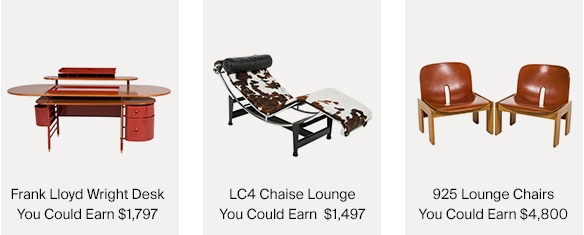
Cassina Frank Lloyd Wright Johnson Wax Desk; Cassina LC4 Chaise Longue Lounge Chair; Cassina 925 Lounge Chairs
The Designer Details: Cassina was founded in 1927 in Brianza, Italy by brothers Cesare and Umberto Cassina. In the beginning, the company concentrated on woodworking. It wasn’t until after WWII that Cassina collaborated with modern designers like Gio Ponti and Le Corbusier to create their Cassina I Maestri (Cassina Masters) collection, which was widely successful.
Resale Stats: Cassina’s Frank Lloyd Wright-designed Johnson Wax Desk holds an average resale value of up to 65%. (Original Johnson Wax furnishings manufactured by Steelcase are incredibly rare and achieve up to $48,000 on the secondary market.) LC4 Chaise Lounges manufactured by Cassina have an average resale value of up to 55%. The 925 Lounge Chairs are no longer in production, but were produced well into the 1980s with a handful of pieces available on the secondary market today. The current secondary market value of each chair is approximately $4,000, depending on factors like condition.
The Stories Behind The Styles: Frank Lloyd Wright is perhaps best known for his stunning early 20th century commercial and home designs, but the architect also created furnishings for the dwellings he designed. The Johnson Wax desk is one such piece, produced by the dozens in several variations in 1936 for the Racine, Washington Johnson Wax Headquarters. The Art Deco desk is as functional as it is aesthetically pleasing with its multi-level design. The desk uses negative space to create a floating quality that mimics the form of the Johnson Wax building. Because it was created exclusively for the Johnson Wax campus, the desk was not mass-produced for retail purchase until Cassina re-issued the design in 1992.
Designed in 1928, the LC4 Chaise Longue (meaning “long chair”) was the brainchild of French architect Charlotte Perriand, Swiss architect Le Corbusier and his cousin Pierre Jeanneret. At just twenty-four years old, Charlotte Perriand created an ultramodern interior space titled Bar Sous le Toit (Bar under the Roof or Bar in the Attic) for the Salon d’Automne exhibition in Paris. The recreation of Perriand’s own flat featured bold geometric designs, shiny tubular chromed steel and rich leathers. The installation caught the eye of Le Corbusier, who had famously rejected Perriand’s previous application to his studio, stating, “We don’t embroider pillows here.” After seeing Bar Sous le Toit, Corbusier invited Perriand to join his design studio where the two, along with Pierre Jeanneret, produced modern collaborative designs for a decade. The LC4 Chaise was first produced by Thonet under the model name of B306 for the Salon d’Automne in 1929. Cassina acquired the exclusive rights to produce the LC4 in 1964, and remains the sole international manufacturer today.
Cassina’s 925 Lounge Chairs were the creation of Italian design duo Afra and Tobia Scarpa in 1966. Before their careers in furnishings and interiors, the couple worked in the glass arts with Venini in Murano, Italy. The 925 chair is part of the permanent collections of the Louvre, the Met, and MoMA. The Scarpas later went on to produce iconic designs for Knoll, B&B Italia and Flos.
Cassina LC4 Chaise Longue Chair Authenticity Tip: Authentic LC4 chaise longues produced by Cassina will always bear Le Corbusier’s signature and a unique serial number embossed on the frame. Later examples will be branded by the I Maestro logotype with the authors’ initials, and all three designers’ signatures. The joints of the frame should also be smoothed and finished, with no evidence of welding apparent at the seams.
Ready to start earning for top furniture designers? Sell now.


